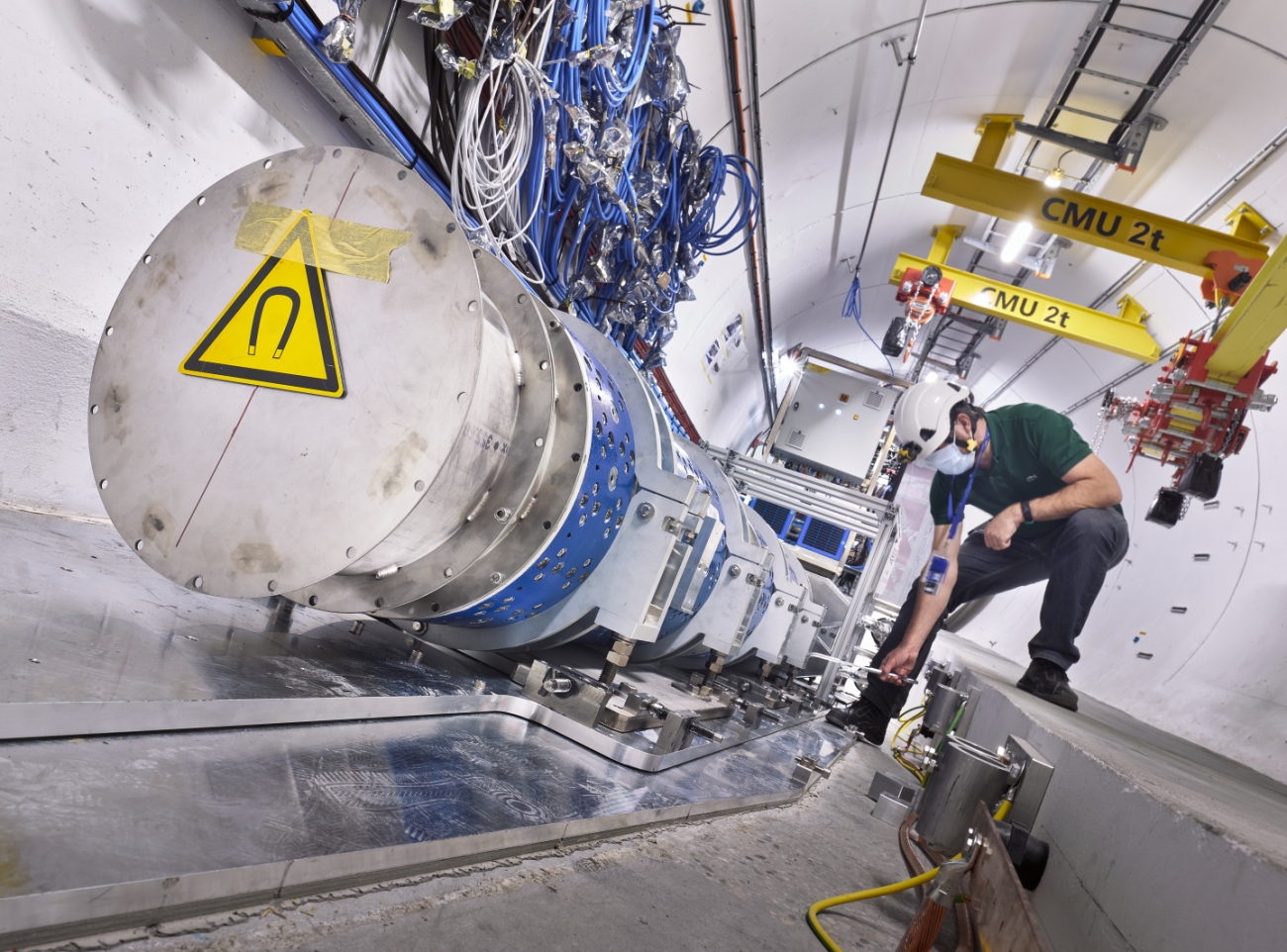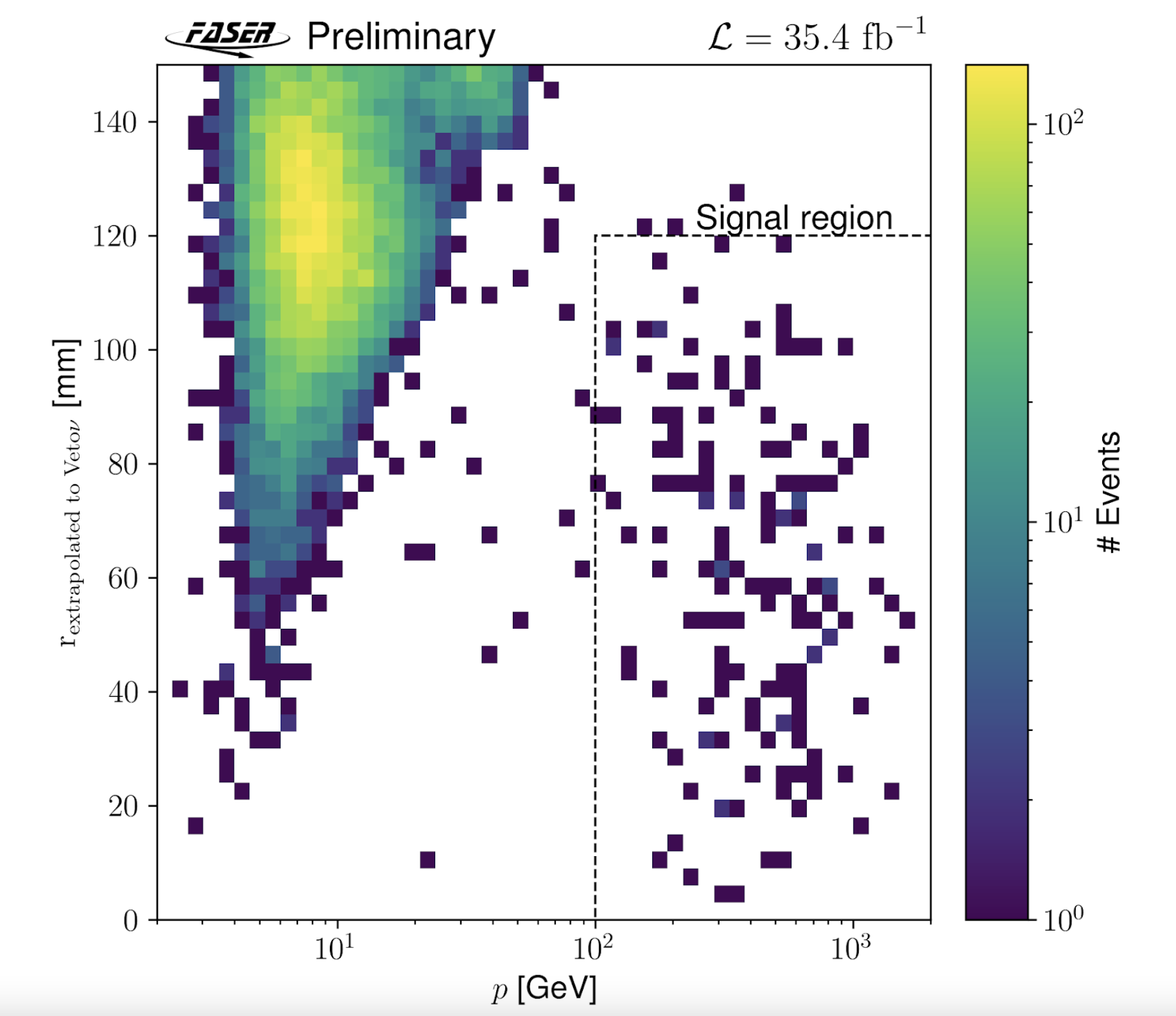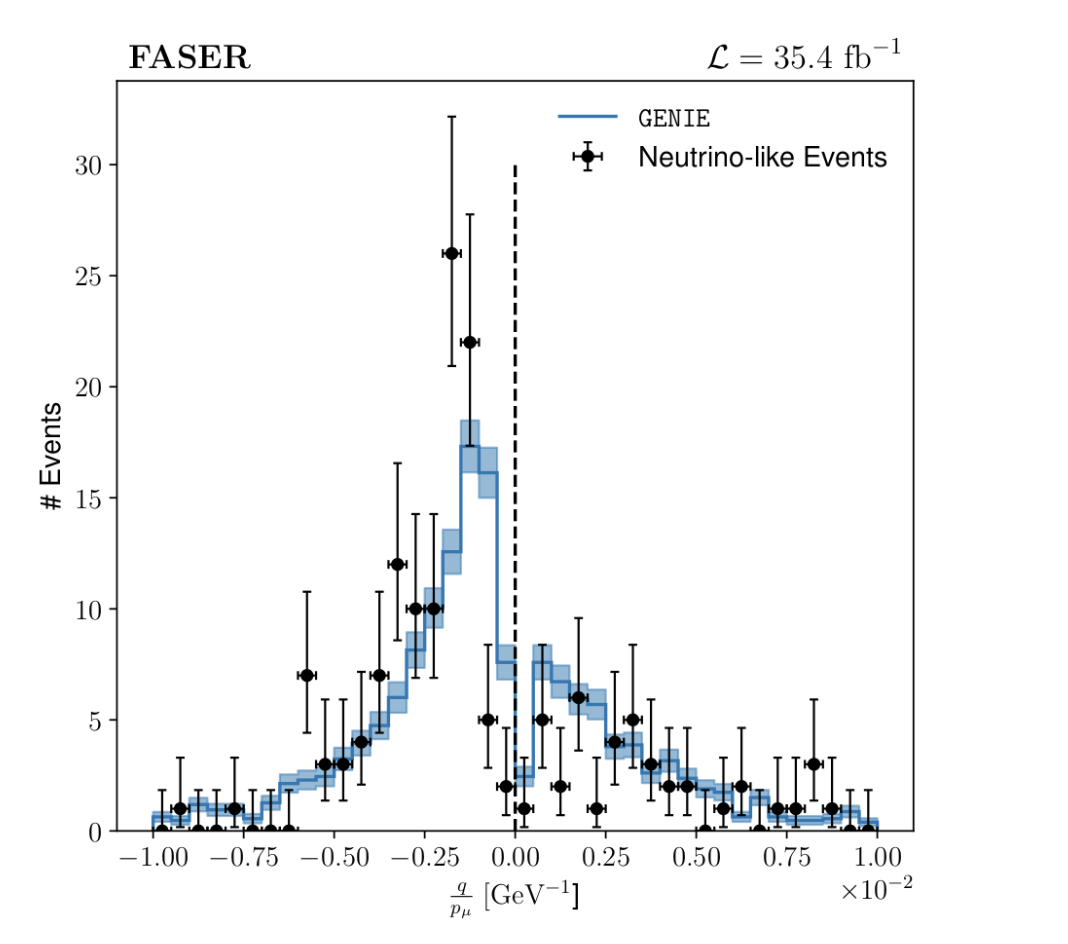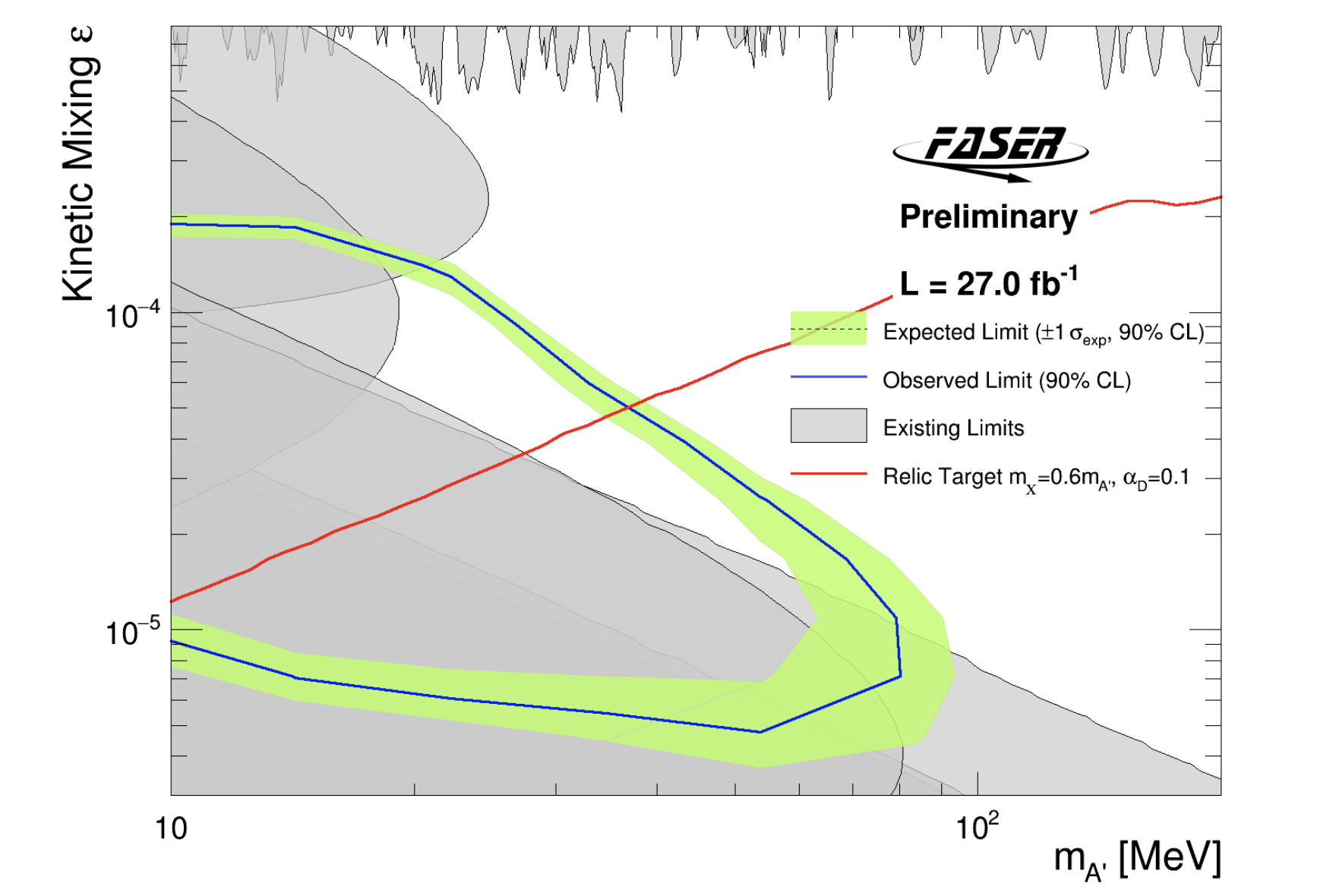First Physics Results from the FASER Experiment

FASER is a new small LHC experiment designed to search for light, weakly interacting, long-lived beyond-standard model particles such as dark photons and to detect high energy neutrinos produced in proton-proton collisions. The FASER detector is located approximately 480m from the ATLAS interaction point along the beam collision axis line-of-sight. Because the particles are extremely weakly interacting, dark photons and neutrinos produced at IP1 may travel along the line-of-sight, pass through 100m of rock and concrete, and then decay or interact in FASER.
FASER was installed during LS2. It has been collecting data since July 2022 with an integrated data taking efficiency of more than 96%. The first two FASER physics results from the 2022 data-set were presented at the 57th Rencontres de Moriond at the end of March.
Observation of Neutrino Interactions

Fig. 1. Schematic side view of the FASER detector with a muon neutrino undergoing a charged-current interaction in the emulsion target.
Until now no neutrino produced at a particle collider has been directly detected, but only inferred through missing energy reconstruction. Colliders copiously produce both neutrinos and anti-neutrinos of all flavors including at very high neutrino energies where neutrino interactions have not yet been observed. Collider neutrinos have escaped detection, because they interact extremely weakly, and the highest energy neutrinos, which have the largest probability of interacting, are predominantly produced in the forward region, parallel to the beam line.
The first FASER search for neutrinos targets muon (anti-)neutrino charged-current interactions in the 1.1 ton tungsten/emulsion detector (FASERν) at the front of FASER as illustrated in Fig. 1. Such interactions will produce a high-momentum muon that can be reconstructed in the three tracker stations of the FASER tracking spectrometer. In addition, the secondary particles produced in the neutrino interactions will typically result in increased activity in both the veto scintillator station and in the IFT tracking station down stream of FASERν, but critically there will be no signal in the veto scintillators located in front of FASERν. The event selection requires all downstream scintillator layers to have a signal consistent with at least one MIP. Events with signals in any of the two layers of the front veto station are rejected as they are likely from incoming muons or other charged particle backgrounds. Only events with a single, good quality track in the three tracker stations with a reconstructed track momentum above 100 GeV are accepted. The track is required to be in the fiducial tracking volume (radius, r<95 mm) of the spectrometer defined by the aperture of the magnets. When extrapolated to the IFT, the track should be within r<120 mm at the first veto scintillator to ensure that it would have passed through the front veto scintillators. Based on simulation of neutrino production from proton-proton collisions about 150 neutrino events are expected to be selected in the 2022 dataset with this selection, but with large uncertainties due to forward hadron production modelling.
The main background processes are expected to be from neutral hadrons produced in muon interactions in the rock/concrete in front of FASER and large angle muons that miss the front veto station and scatter into the spectrometer in FASERν. Both background processes are estimated to be well below one event using a combination of simulation and data control regions. The background from muons passing through the front veto scintillator undetected is measured to be negligible.

Fig. 2. The selected signal region in extrapolated radius at the veto scintillator and reconstructed track momentum is depicted. The region with lower momenta and larger radii is dominated by background events consisting of charged particles that miss the FASERν scintillator station.
Figure 2 shows the selected events, as well as background-enriched regions around the signal region. In total we observe 153 events passing all selection criteria well-separated from the background. A typical neutrino candidate event is shown Fig. 3. The statistical significance of the neutrino signal is estimated using a binned extended maximum likelihood fit taking into account the background estimates above and gives a statistical significance of 16 standard deviations over the background-only hypothesis. This is a conclusive first direct observation of neutrino interactions at the LHC. Figure 4 shows the distribution of the charge-signed inverse momentum of the muon candidates (q/p) showing that the muons and consequently also the interacting neutrinos have energies that are significantly larger than 200 GeV. A clear charge separation in q/p for the reconstructed tracks is also observed with a total of 40 events with a positively charged track, demonstrating the presence of both neutrinos and anti-neutrinos in the analyzed data set.

Fig. 3. Event display of a neutrino interaction candidate in which secondary particles produced in the neutrino interaction produce activity in the IFT.

Fig. 4. Charged-signed inverse momentum in GeV-1 for reconstructed track in neutrino-like events in data and simulated neutrino events using GENIE generator.
Search for Dark Photon Decays
Dark photons are particles of hidden sector models motivated by dark matter. If the dark sector has a U(1) electromagnetic force, the dark gauge boson can mix with the SM gauge boson, leading to a new spin-1 gauge boson, the dark photon A’, which is among the leading targets for dark sector searches. The dark photon is characterized by its mass, m(A’), and coupling parameter, ε. FASER is most sensitive to dark photons with m(A')~10-100 MeV and ε~10-5-10-4. In this region of parameter space, at the LHC the dark photon is primarily produced through neutral pion decays to A’γ and decays to an e+e- pair with a typical decay length in the forward direction of tens to hundreds of meters. Hence, the dark photon signature in FASER is the appearance of a track pair in the designated decay volume between the last veto scintillator and the spectrometer associated with a large energy deposition in the electromagnetic calorimeter.
The dark photon analysis uses simple, robust selection criteria optimized for an early discovery. All five veto scintillator layers are required to have no signal, vetoing events with any incoming charged particles or interactions with the FASERν detector. Exactly two good quality reconstructed tracks with momentum above 20 GeV inside the fiducial tracking volume are required. The extrapolations of both tracks to the first scintillator station must have a radius within 95 mm to suppress particles coming at a large angle. Finally, a deposited energy of 500 GeV or more in the calorimeter is required. This selection has a signal efficiency of 40-50% for dark photons decaying inside the decay volume.
The main background processes remaining after all selections are estimated to be neutrino interactions in the detector and neutral hadrons decaying in the decay volume. These are estimated from simulation and data control regions to less than 0.002 events.

Fig. 5. The calorimeter energy distribution after various levels of selections for data and expected signal for three representative signal models. (top left) after a reconstructed track requirement; (top right) after a reconstructed track requirement, and with no signal in the veto scintillators; (bottom left) after a fiducial track requirement and no veto scintillator signal; (bottom right) after a fiducial two track requirement and no veto scintillator signal.
The figure above (Fig.5) shows the calorimeter energy distribution after different stages in the event selection. No data events remain after just requiring no signal in the veto layers and at least one track in the fiducial region. Given that no events are observed, the results are used to set exclusion limits on dark photons at 90% confidence level. Figure 6 shows the exclusion limit in the signal parameter space. The first FASER dark photon result provides exclusion for previously viable models including in a cosmologically interesting region of parameter space as indicated by the example relic target model overlaid on the plot.

Fig. 6. The 90% confidence level exclusion contour in the dark photon model parameter space. Regions excluded by previous experiments are shown in grey. The red line shows the region of parameter space which yields the correct dark matter relic density in a specific model.
Summary
The FASER experiment has produced its first physics results. More than 150 neutrino and anti-neutrino interactions have been detected, the first direct detection of neutrinos produced at a collider. No dark photon decays are observed in an almost background free search where the dark photon decays to e+e-. This search is used to set new limits in a cosmological relevant region of parameter space. These results are the start of the FASER physics programme with many more results to come in the next years, with up to 10x more data expected before the end of LHC Run 3.
